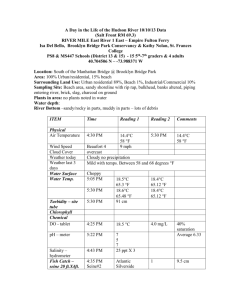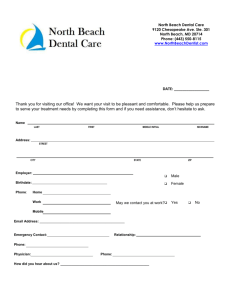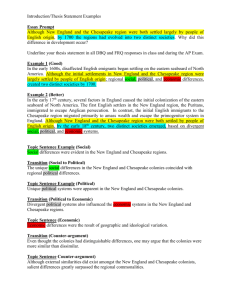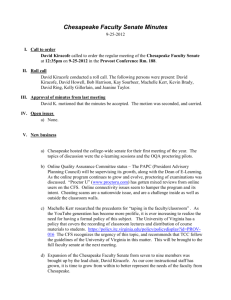Historic Properties Form
advertisement
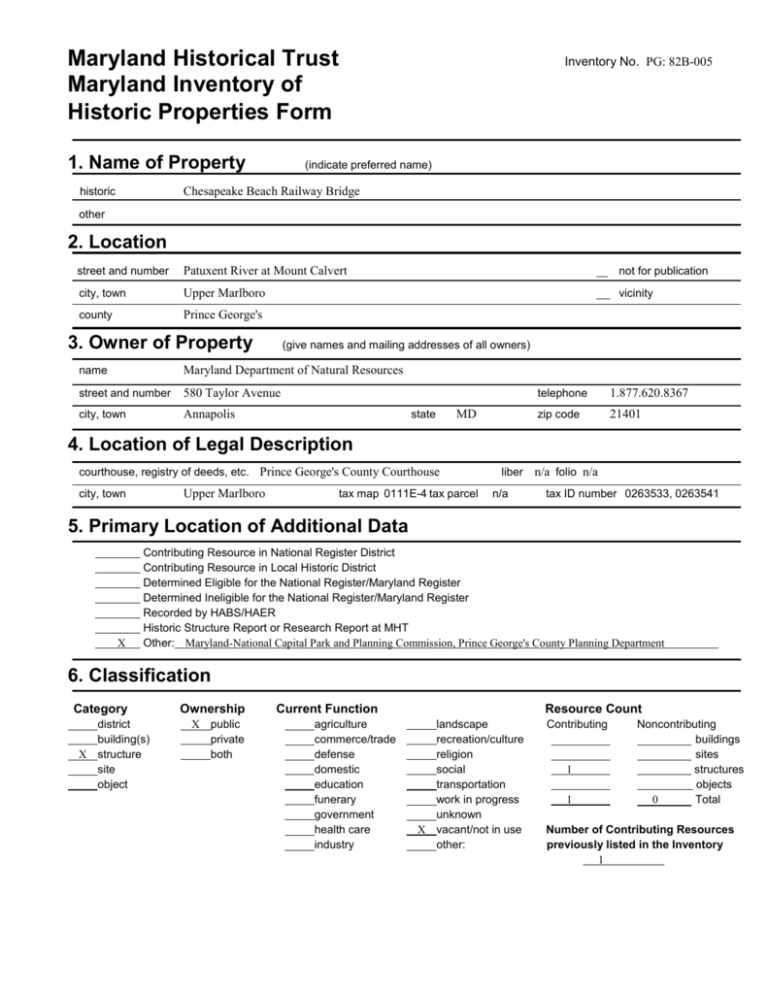
Maryland Historical Trust Maryland Inventory of Historic Properties Form 1. Name of Property Inventory No. PG: 82B-005 (indicate preferred name) Chesapeake Beach Railway Bridge historic other 2. Location street and number Patuxent River at Mount Calvert not for publication city, town Upper Marlboro vicinity county Prince George's 3. Owner of Property (give names and mailing addresses of all owners) name Maryland Department of Natural Resources street and number 580 Taylor Avenue city, town Annapolis state MD telephone 1.877.620.8367 zip code 21401 4. Location of Legal Description courthouse, registry of deeds, etc. Prince George's County Courthouse Upper Marlboro city, town tax map 0111E-4 tax parcel liber n/a n/a folio n/a tax ID number 0263533, 0263541 5. Primary Location of Additional Data X Contributing Resource in National Register District Contributing Resource in Local Historic District Determined Eligible for the National Register/Maryland Register Determined Ineligible for the National Register/Maryland Register Recorded by HABS/HAER Historic Structure Report or Research Report at MHT Other: Maryland-National Capital Park and Planning Commission, Prince George's County Planning Department 6. Classification Category district building(s) X structure site object Ownership X public private both Current Function agriculture commerce/trade defense domestic education funerary government health care industry Resource Count landscape recreation/culture religion social transportation work in progress unknown X vacant/not in use other: Contributing 1 1 Noncontributing buildings sites structures objects 0 Total Number of Contributing Resources previously listed in the Inventory 1 7. Description Inventory No. PG: 82B-005 Condition excellent good fair deteriorated X ruins altered Prepare both a one paragraph summary and a comprehensive description of the resource and its various elements as it exists today. The Chesapeake Beach Railway Bridge once span approximately 400 feet of the Patuxent River south of Mount Calvert, Maryland. Constructed in 1898 by the Youngstown Bridge Company, the single-line swing span railway bridge ran east-west.1 The area surrounding the site of the bridge consists of marshlands, agricultural fields, and forestland. The Patuxent River flows southeasterly from the middle of the state, past Laurel and forms the border between Prince George’s and Anne Arundel County. It empties into the Chesapeake Bay at the town of Solomon’s, Maryland. BRIDGE The Chesapeake Beach Railway Bridge is currently a ruin. At the time of the 2007 on-site survey, the wood swing span bridge’s pivot pier was the only extant segment of the bridge. INTEGRITY The Chesapeake Beach Railway Bridge retains no level of integrity. The bridge span is no longer extant. The only extant part of the structure is the pivot pier, located in the middle of the Patuxent River. The bridge does not retain any integrity of association, feeling, location, workmanship, material, and design. The bridge retains a low integrity of setting, as the area surrounding the site of the bridge remains rural. Marshlands line the Patuxent River while the surrounding land is a mix of agricultural fields and forest. The Chesapeake Beach Railway Bridge does not retain sufficient integrity to convey the characteristics for which it is significant. 1 “Railroad Notes,” Prince George’s Enquirer (20 May 1898). 8. Significance Period Areas of Significance 1600-1699 1700-1799 X 1800-1899 1900-1999 2000- agriculture archeology architecture art commerce communications community planning conservation Specific dates 1898 Construction dates 1898 Inventory No. PG: 82B-005 Check and justify below economics education engineering entertainment/ recreation ethnic heritage exploration/ settlement health/medicine performing arts industry philosophy invention politics/government landscape architecture religion law science literature social history maritime history X transportation military other: Architect/Builder Youngstown Bridge Company Evaluation for: National Register Maryland Register not evaluated Prepare a one-paragraph summary statement of significance addressing applicable criteria, followed by a narrative discussion of the history of the resource and its context. (For compliance projects, complete evaluation on a DOE Form – see manual.) STATEMENT OF SIGNIFICANCE Constructed in 1898 by the Youngstown Bridge Company, the Chesapeake Beach Railway Bridge is notable as a component of the railway line that connected Washington, D.C. with Chesapeake Beach, Maryland. An integral part of the Chesapeake Beach Railway, herein referred to as CBR, the bridge facilitated the development of the resort town of Chesapeake Beach. HISTORIC CONTEXT The site of the Chesapeake Beach Railway Bridge is located in eastern Prince George’s County, approximately three miles to the southeast of Upper Marlboro and directly east of the Mount Calvert Historical and Archaeological Site. The advent of the railroad in the early nineteenth century and the subsequent advancements made during the nineteenth century made it possible for more middle-class Americans to travel. It also provided an efficient mode of distribution of agricultural and commercial products throughout the country. The railroad effectively enhanced the ease and reduced the cost for many people to take weekend vacations, as was commonplace for Washington, D.C. residents at the end of the eighteenth century. The Washington and Chesapeake Beach Railway Corporation owned 718 acres of land on the Chesapeake Bay on which the resort town of Chesapeake Beach was built.2 The new resort town would offer the citizens of Washington, D.C. a beach resort community in close proximity that would rival Newport, Rhode Island.3 The Washington and Chesapeake Beach began construction of the railway that would link Chesapeake Beach with the growing population of Washington, D.C. In 1896, the newly formed CBR took over operations of the railway and resort construction. Led by established Colorado railway builder Otto Mears, the CBR set out to complete the project. Mears immigrated to America from Russia in 1880 and quickly began establishing himself as a preeminent president of his railway and toll 2 3 Susan G. Pearl, “Railroads in Prince George’s County, 1835-1935” Historic Contexts in Prince George’s County (1991), 45. Susan G. Pearl, “Railroads in Prince George’s County, 1835-1935” Historic Contexts in Prince George’s County (1991), 45. Maryland Historical Trust Maryland Inventory of Historic Properties Form Inventory No. 82B-005 Chesapeake Beach Railway Bridge Continuation Sheet Number 8 Page 1 road company. Before completion of the Chesapeake Beach Railway line Mr. Mears completed several railway lines in Colorado, the most notable being the Silverton Railroad and the Rio Grande Southern. The Rio Grande Southern was built by Mears in 1890 to reach the rich mining districts of Telluride and Rico.4 The Washington and Chesapeake Beach Railway Corporation was formed in 1891 and by 1894 granted a charter to incorporate the town of Chesapeake Beach. The plans of the W&CBR were never implemented, and in 1896 Otto Mears formed the CBR. The CBR came about as a means to transport people and goods from Washington, D.C. to Chesapeake Beach and points between. His plan was popular as many landowners deeded a right-of-way through their properties for the railway.5 In all, fifty landowners in Prince George’s County either deeded property or granted a right-of-way to the Chesapeake Beach Railroad Company from 1891-1915. Mears’ vision of providing rail service to Chesapeake Beach became a reality on June 9, 1900 when the first train arrived in Chesapeake Beach from Washington, D.C.6 From 1900 until 1930 Chesapeake Beach was a thriving independent community. People came for day trips by railway and steamboats. The resort town offered roller coasters, a boardwalk, and the amenity of swimming in the Chesapeake Bay. Overnight visitors could stay in the luxurious Belvedere Hotel, which was built c. 1900.7 The Chesapeake Beach Railway Bridge was a single-line bridge constructed of wood. The Youngstown Bridge Company was commissioned to build and install the swing span bridge across the Patuxent River, just southeast of the historic site of Mount Calvert.8 In the flat Tidewater region, where elevation drops are not so large, wood was still the best available material.9 Wood had primarily given way to metal as the preferred material of choice in bridge construction. Steel offered the convenience of increased strength and longevity with reduced weight. This did not sway the CBR though, as wood was cheap and plentiful, and hence the material of choice for all CBR bridges.10 Multiple bridges were built on the CBR that spanned waterways, low areas, and roads. For the soft muddy soil of the Tidewater region, short timber-beam spans still seemed the best choice.11 4 John Humphrey, "Rio Grande Southern - History," Science Today (20 October 2000) [journal on-line]; available from http://rgs.railfan.net/; Internet; accessed 11 September 2007. 5 Maryland State Highway Administration Plaque, located at the Chesapeake Beach Railway Bridge site on the western side of the Patuxent River. 6 Chesapeake Beach Railway Museum, “Museum History,” http://www.cbrm.org/History.htm (accessed September 12, 2007). 7 The Town of Chesapeake Beach, “History,” http://chesapeake-beach.md.us/ourtown_history.htm (accessed November 2, 2007). 8 Susan G. Pearl, “Railroads in Prince George’s County, 1835-1935” Historic Contexts in Prince George’s County (1991), 45. 9 Dixie Legler and Carol M. Highsmith, Historic Bridges of Maryland (Crownsville: Maryland Historical Trust Press, 2002), 18. 10 John Riedesel, “Ghosts Along the Right-of-Way,” Chesapeake Beach Railway Museum [on-line]; available from http://www.cbrm.org/historicalarticles/may_2005_right_of_way.pdf (accessed November 2, 2007). 11 Dixie Legler and Carol M. Highsmith, Historic Bridges of Maryland (Crownsville: Maryland Historical Trust Press, 2002), 40. Maryland Historical Trust Maryland Inventory of Historic Properties Form Inventory No. 82B-005 Chesapeake Beach Railway Bridge Continuation Sheet Number 8 Page 2 The choice of building a swing span bridge highlights the importance placed on keeping the Patuxent River navigable. A swing span bridge pivots allowing river traffic to pass the bridge when necessary. For less crowded sites, the swing span remained a viable form of technology well into the twentieth century. Most surviving swing spans, for example, are railroad bridges in rural regions. 12 This sediment was shared throughout the country as virtually all nineteenth-century movable bridges were of the swing span variety.13 Specifications for CBR bridges called for 12-by-12 inch, seasoned oak timbers, with mortised and bolted joints. In an effort to speed construction and save money, logs were used, many with the bark still on; and they were spiked together rather than bolted.14 The hasty construction technique utilized to build the bridges on the CBR is the primary reason why the only part still extant of the Chesapeake Beach Railway Bridge is the bridge pivot. The Chesapeake Beach Railway Bridge at Mt. Calvert was an integral part of the CBR that facilitated the birth and expansion of the city of Chesapeake Beach, Maryland. Mount Calvert became a stop on the railway itself in 1899. Chesapeake Beach and the CBR continued to prosper during the first part of the twentieth-century. This growth would come under attack, as would all railway travel with the development of the automobile. The greatest threat to the viability of the CBR was the proliferation of the automobile. By the turn of the twentieth century, Maryland’s deeply rutted and nearly impassable roads, long neglected in favor of the railroads and canals, slowly began to improve. By the 1920s the state’s modernized roads surpassed rail as the primary means of moving people and goods.15 As a result, starting in 1921 the CBR started experienced decreasing revenues.16 People and goods could travel quicker and at a more cost efficient manner when compared to rail travel. The Chesapeake-Potomac Hurricane of 1933 combined with the Great Depression of 1935 brought an end to the Chesapeake Beach Railway Company on April 15, 1935. The rails were pulled up, with the final train trip April 15, 1935. The Town of Chesapeake Beach continued to flourish without the CBR in the years following the Great Depression. The groundwork had been laid by Otto Mears and his CBR for the town’s continued development to present-day. At the time of the 2007 on-site survey, the bridge pivot remained in the middle of the Patuxent River. A metal pedestrian pier has been constructed on the eastern side of the river. The pier is situated on the historic path of Minnesota’s Historic Bridges, “Stillwater Bridge,” Minnesota Historical Society [on-line]; available from http://www.mnhs.org/places/nationalregister/bridges/nrwasb/sign.html; (accessed 2 November 2007). 13 Minnesota’s Historic Bridges, “Stillwater Bridge,” Minnesota Historical Society [on-line]; available from http://www.mnhs.org/places/nationalregister/bridges/nrwasb/sign.html; (accessed 12 September 2007). 14 John Riedesel, “Ghosts Along the Right-of-Way,” Chesapeake Beach Railway Museum [on-line]; available from http://www.cbrm.org/historicalarticles/may_2005_right_of_way.pdf; (accessed 12 September 2007). 15 Dixie Legler and Carol M. Highsmith, Historic Bridges of Maryland (Crownsville: Maryland Historical Trust Press, 2002), 22. 16 “CBR Closure,” Chesapeake Beach Railway Museum [on-line]; available from http://www.cbrm.org/historicalarticles/nov_98_railway_closure.pdf; (accessed 12 September 2007). 12 Maryland Historical Trust Maryland Inventory of Historic Properties Form Inventory No. 82B-005 Chesapeake Beach Railway Bridge Continuation Sheet Number 8 Page 3 the CBR and extends west to the edge of the Patuxent. The Maryland Department of Natural Resources owns the property. 9. Major Bibliographical References Inventory No. PG: 82B-005 Chesapeake Beach Railway Museum. Ghosts Right-of-Way. Available from http://www.cbrm.org. Chesapeake Beach Railway Museum. CBR Closure. Available from http://www.cbrm.org. Humphrey, John. Rio Grande Southern – History. Available from http://rgs.railfan.net. Legler, Dixie and Carol M. Highsmith. Historic Bridges of Maryland. Crownsville: Maryland Historical Trust Press, 2002. Minnesota Historical Society. Stillwater Bridge. Available from http://www.mnhs.org. Pearl, Susan. “Chesapeake Beach Railway Bridge” (PG: 82B-5), Maryland Historic Trust State Historic Sites Inventory Form, 1991. Maryland-National Capital Park and Planning Commission and Prince George’s County Planning Department, Historic Sites and Districts Plan, 1992. 10. Geographical Data Acreage of surveyed property Acreage of historical setting Quadrangle name n/a n/a Bristol Quadrangle scale: 1:24,000 Verbal boundary description and justification The Chesapeake Beach Railway Bridge site is located along and in the Patuxent River directly south of the Mount Calvert historic site. The site is bordered to the west by the Mount Calvert Historical and Archaeological Park property and to the east by the Prince George’s County/Anne Arundel County line. Historically the bridge spanned the Patuxent River, extending east from a spot in the southeastern corner of the Mount Calvert Historical and Archaeological Park property. At this point the Patuxent River is approximately 400 feet in width. The Chesapeake Beach Railway Bridge is associated with Tax Map 0111E-4. 11. Form Prepared by name/title Paul Weishar, Architectural Historian organization EHT Traceries, Incorported date February 2008 street & number 1121 Fifth Street NW telephone 202.393.1199 city or town Washington state D.C. The Maryland Inventory of Historic Properties was officially created by an Act of the Maryland Legislature to be found in the Annotated Code of Maryland, Article 41, Section 181 KA, 1974 supplement. The survey and inventory are being prepared for information and record purposes only and do not constitute any infringement of individual property rights. return to: Maryland Historical Trust Maryland Department of Planning 100 Community Place Crownsville, MD 21032-2023 410-514-7600 Maryland Historical Trust Maryland Inventory of Historic Properties Form Inventory No. PG: 82B-005 Chesapeake Beach Railway Bridge Continuation Sheet Number 9 Page 1 CHAIN OF TITLE PRINCE GEORGE’S COUNTY LAND RECORDS Many land records exist concerning the conveyance of land for the building of the Chesapeake Beach Railway. A specific record regarding the land this Chesapeake Beach Railway Bridge is associated with could not be located. Maryland Historical Trust Maryland Inventory of Historic Properties Form Inventory No. Chesapeake Beach Railway Bridge Continuation Sheet Number 9 Page 2 Photo: Chesapeake Beach Railway Bridge, view from the northwest. (August 2007) PG: 82B-005 Maryland Historical Trust Maryland Inventory of Historic Properties Form Chesapeake Beach Railway Bridge Continuation Sheet Number 9 Page 3 Photo: Chesapeake Beach Railway Bridge, historic photo. (Date Unknown) Inventory No. PG: 82B-005
